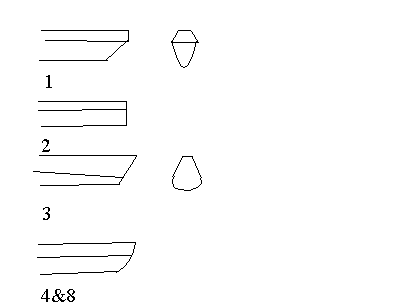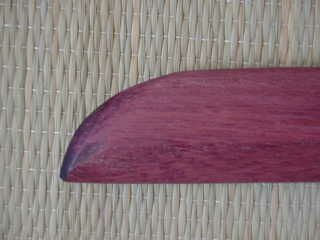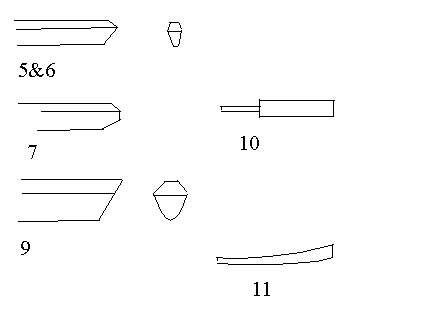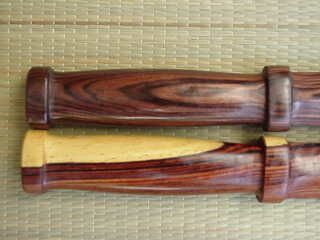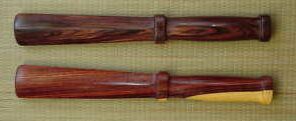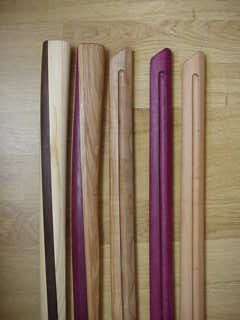BOKUTO (bokken)These weapons are made by me, Kim Taylor from a variety of woods. The designs below can all be adjusted and adapted to individual requirements. Since these weapons are each hand crafted, measurements should be taken as approximations for comparison purposes, they will vary somewhat in the finished product. I do try to match your requirements but hand made weapons are difficult to make in 1/16 inch tolerances.For more on my woodworking, check out my personal pages. In the measurements below the terms are as follows. LOA: Length over all, from one end to the other. Handles are usually about 10.5 inches. Sori: This is the maximum curvature from the mune (back) to a straight line running from the tip to the butt end. Tsuka Gashira: The butt end of the handle, this is oval shaped in almost all these styles. Kissaki: The tip end, the dimensions viewed end on. Tsuba: The sword guard. (Sword guard area) 1. SEI DO KAI The "Sei Do Kai" Bokuto is a general purpose design with a blunted tip for safety. The cross section is standard with a flat mune (top), the shinogi ji (area from top to the maximum width) is also flat, then an oval shape to the ha (edge). The tip is cut off flat from the mune to the shinogiline (widest part of the blade), and angled back toward the tsuka (handle) from shinogi to ha. I developed this design out of the very first bokuto I ever owned, an Aikido Iwama style. The tip and a little bit of the balance was changed over the years. LOA 40 ½ inches, sori 3/4 inches tsuka gashira 1 ½ x 1 inch, kissaki 1 1/4 x 11/16 inch
2. IWAMA The "Iwama Aikido" style has a standard cross section with a squared tip (no "point"). Very similar to the Sei Do Kai (#1). LOA 40 ½ inches, sori3/4 inches tsuka gashira 1 ½ x 1inch, kissaki 1 1/4 x 11/16
inch 3. JIGEN RYU The "Jigen Ryu" has a tear drop shape at the kissaki, with more meat on the edge than on the back.This is a real "edge banger", it will take a lot of pounding on the edge, but it isn't much thicker in diametre than the Sei Do Kai so it retains its lightness. It comes in a curved and a straight form. The "point" runs in a straight line from the mune to the ha. LOA 40 ½ inches, sori ½ inch tsuka gashira 1 1/4 x 1 inch, kissaki 1 1/4 x 13/16
inch 4. KENDO NO KATA In the "Kendo no Kata", the butt end of the handle is slightly smaller than the tsuba end. There is a shoulder at the position of the tsuba for a plastic or leather tsuba to be fitted. The point runs in a curve from the mune to the ha. LOA 40 inches. sori 1 inch tsuka gashira 1 3/8 x 1 inch, tsuka at tsuba 1 ½ x 1
inch, kissaki
1 x 3/4 inch 5. NITEN ICHI RYU The style used by the Hyo Ho Niten Ichi-ryu (Musashi Miyamoto's school). The "edge" is squared,like the mune. The tip is two angles with the furthest point forward being the shinogi. Very thin and light, usually sold in a pair with the shoto which is 3/5 as long. Please note, these blades are 3/4 inch wide rather than the full inch of other models. LOA 40 1/4 inches, sori 3/8 inches tsuka gashira 1 1/4 x 3/4 inch, kissaki 1 1/16 x ½ inch
6. MUSASHI SUBURITO A style based on the oar Musashi carved at Ganryu-jima. This shape is roughly the same as for the niten ichi ryu bokuto, but much longer and wider at the tip. The blade sides are three flat planes. LOA 50 inches, sori 1 1/8 inches tsuka gashira 1 3/8 x 15/16 inch, kissaki 2 x 3/4 inch
7. KATORI SHINTO RYU A shorter, lighter bokuto with a standard shape. The tip is similar to the Niten Ichi Ryu, but it has three planes instead of two. LOA 38 1/2 inches, sori 5/8 inches tsuka gashira 1 3/8 x 1 inch, kissaki 1 1/16 x 3/4 inch 8. SHINDO MUSO RYU
This is a standard shape, almost identical to the kendo no kata, with a somewhat thinner blade and a shorter tsuka. It has a shoulder at the tsuba for a leather guard.
The tip is a curved line from mune to ha, similar to the Kendo no Kata (#4).
LOA 40 inches, Sori 5/8inches tsuka gashira 1 ½ x1", kissaki 1 1/8 x 5/8"
This is a thick, straight bokuto with a large round wooden tsuba (3" dia, 1"thick). The tip is a curved line from mune to ha. LOA 40 ½ inches, sori 0 inches tsuka gashira 1 5/8 x 1 1/4", kissaki 1 1/2 x 1 1/8" 10. TANREN BO A strength training tool of highly variable shape and
size.
The "standard"
is three feet long, three inches square with a ten inch
handle of oval
shape, 1½ inches by 1 inch. Other shapes are also
possible. 11. SUBURI TO These are also highly variable, from scaled up bokuto to specialized shapes such as a "comma"shape, with a handle that flares out in a curve allowing a wide degree of forearm loading, depending on where it is gripped. Got a different style? I'll try it for you, all bokuto (including those with a specific "name") can be supplied to your specified length. Contact me for a price quote. Any of the above can be purchased in various woods, depending on availability of suitable stock. Bokuto begin at $54. Discounts are available for bulk orders. I usually have a small number of bokuto in various styles in stock, some of these may have a "scratch and dent" discount applied. I have also developed a semi-production model I call
the "club
bokuto"
this is usually made from "hardwood" (whatever I can
find at a good
price,
often a mixture of woods). These are sold in lots of 10
or more, and
the
price is $30 each plus shipping costs. The style is the
generalized
"Sei
Do Kai" (I've recently discovered this tip style is the
same as that
used
on Tendo-ryu bokuto), with a moderate even curve. The
tip is 3/4 inch
wide
which gives the bokuto lots of "beef" for heavy use.
There is no
shoulder
but a tsuba can be fitted using a rubber ring on both
sides. We will
supply OTHER WEAPONSIf it's made of wood I can likely make it for you. Call and ask about pricing on special orders. Some of the other weapons I make are listed below.HIKING/SELF DEFENSE STICKS Walking sticks and staffs in stock begin at $35 and feature a variety of styles and woods, often laminated in whimsical ways. The typical cane has a T-shaped handle some with metal tips, some plain. Staffs are usually 5 feet long with a retaining cord and perhaps a bear bell. Special orders are also available in any shape you can imagine. A potential feature that may interest the photographers
is a
monopod
adaptor in the head of the staff. Just screw off the top
of your trusty
stick, screw on the camera and snap away without the
need to find a
tree
branch for stability. JO Jo can be made to any size but the most common is either one inch diameter and 50 1/4 inches length (Shindo Muso Ryu), or 1 1/8 inch diameter and 50 inches (Aikido). Jo are available in most of the same woods as Bokuto. YARI Spears of any length up to 9 feet are no problem.
(Longer
weapons must
be specially shipped at greater cost). It is highly
recommended that
you
choose hickory, ash or white oak for weapons of this
size. I can
produce
the weapons with oval or circular shafts, and with a
taper if you
wish.The
usual design comes with no "tip" and is intended to have
a padded
leather
ball fitted. I can put a hole in the end, fit a rubber
stopper, or do
anything
else you might desire which would help hold the padding
in place. NAGINATA It is highly recommended that you use hickory, white ash or white oak for naginata, especially if your particular blade design has a prominent tip which is subject to breaking off. I have made several different styles, and will gladly work from your design to supply a weapon suitable to your practice.
BO Bo are available straight (usually 1" or 1 1/8") or
tapered
toward each
end. Some of the more exotic woods are only rarely
available in
suitable
length for bo, but I are willing to try to find any wood
you might
wish. TANJO/HANBO Walking stick length weapons with and without cords, tapered or straight, with or without a metal cap... you name it and I'll try it. YAWARA AND ESCRIMA STICKS Anything from three inches to three feet. Describe it and I'll make it for you in whatever wood you might desire.
Here are a couple of tessen, top is kingwood, bottom is cocobolo (with a flash of sapwood)
TANTO Looking for something special to give sensei? How about a tanto made from an oak tree that was standing 5000 years ago. Bog Oak is wood recovered from peat bogs in England and is almost jet black in colour but still has a recognizably oak grain. I call it "perspective wood"... when you think the world is getting too tough to handle, think of someone standing in the shade of this tree. In Egypt the pyramids were being planned, and dogs were being domesticated. In Crete the great stone temples are being built. In Sumeria they've just figured out how to write. And where this tree is growing, Stonehenge is 1000 years in the future. As you might suspect, this wood is a little cranky and it showed a tendency to split while drying but it's fairly stable now. Of course I can make tanto out of any other wood you
might
wish. LAMINATION
Recently I've been doing a lot of custom lamination work to create distinctive weaponry. This has involved woods of contrasting colour, usually in three layers. If you can't decide between two different woods, for a small price I'll combine them to save you the anguish. I usually have one or two of these kicking around so ask, you never know what you might talk me into selling you. EBONIZED
OAK Click the photos for larger pictures.
REFURBISHING WEAPONS Just like a metal blade, a wooden weapon benefits from
the
occasional
refurbishing to remove chips and splinters and to
sharpen up lines
dulled
with long use. I can refinish your old favourites,
removing the minimum
amount of wood so as to change the weight and shape as
little as
possible.
I can also reshape weapons, lighten them or adjust the
balance if you
wish. WOOD FOR WEAPONSPricing for weapons varies depending on the particular weapon and on the wood. There are 5 levels of pricing for wood as follows.1. Domestic hardwoods: Hickory, Pecan, Maple, Ash, Elm, Beech, Oak (red or white), Cherry, Sycamore, Birch etc. 2. Purpleheart 3. Imported hardwoods: Afromosia, Bloodwood, Bubinga, Leadwood, Osage Orange, Teak etc. 4. Rosewoods: specifically Cocobolo, Tulipwood and Kingwood, as well as such rare and expensive woods as Ziricote, Bokote, Bog Oak and a few others. 5. Ebony and Lignum Vitae: These woods are extremely expensive, and are very prone to warps or cracks, so a premium price is required. If you would like to see one of these woods, consider buying a letter opener made of it.These are of various sizes and shapes and are priced at $12, plus $3 for shipping and packing. For those with access to the World Wide Web, you can get information on various woods at www.woodworkerssource.net including photographs. For more information check out the woodworking page. For price quotes on weapons contact Kim Taylor at: 44 Inkerman Street tel 519-836-4357
|
